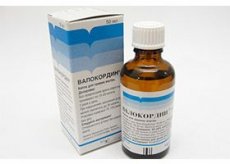Medical expert of the article
New publications
Preparations
Valocordine
Last reviewed: 03.07.2025

All iLive content is medically reviewed or fact checked to ensure as much factual accuracy as possible.
We have strict sourcing guidelines and only link to reputable media sites, academic research institutions and, whenever possible, medically peer reviewed studies. Note that the numbers in parentheses ([1], [2], etc.) are clickable links to these studies.
If you feel that any of our content is inaccurate, out-of-date, or otherwise questionable, please select it and press Ctrl + Enter.

The drug Valocordin belongs to the pharmacological group of sedatives that affect the central nervous system and vascular system.
Other trade names: Corvaldin, Valordin, Valoferin, Valoserdin, Lavocordin.
Indications Valocordine
Release form
Valocordin is available in the form of alcohol-containing drops (in dark glass bottles with a dropper, capacity - 20 or 50 ml).
 [ 3 ]
[ 3 ]
Pharmacodynamics
The action of the drug Valocordin is ensured by the components included in its composition.
The barbituric acid derivative phenobarbital (5-phenyl5-ethylbarbituric acid), interacting with the receptors of the neurotransmitter GABA that inhibit nerve impulses, reduces the excitability of the central nervous system and thereby calms, promotes sleep and relaxes the muscular walls of blood vessels.
The hypnotic, sedative and antispasmodic action of ethyl bromisovalerate (ester of α-bromisovaleric acid) in its mechanism – slowing down the passage of nerve signals – is close to the action of isovaleric acid, contained in the roots of medicinal valerian.
Peppermint oil (menthol) irritates the receptors of the mucous membranes and promotes reflex vasodilation, relieving vascular spasms (including coronary vessels) and reducing pain.
Hop oil included in the drug Valocordin contains a ketone compound methyl nonyl ketone (butanone) that depresses the central nervous system. As an unsafe irritating organic substance, it is included in the ATSDR registry (USA).
 [ 4 ]
[ 4 ]
Pharmacokinetics
After internal use, phenobarbital is adsorbed from the gastrointestinal tract into the systemic bloodstream, protein binding is 20-45%; maximum plasma concentration is observed after 8-12 hours; bioavailability is approximately 90%. Long-term use of Valocordin leads to accumulation of 5-phenyl5-ethylbarbituric acid in blood plasma.
Phenobarbital is a long-acting barbiturate, so its effects last from four hours to two days. The half-life can be 2-7 days. It is metabolized in the liver (by hydroxylation and glucuronidation), the metabolites are excreted from the body mainly by the kidneys.
Regarding the pharmacokinetics of ethyl bromisovalerate, it is only indicated that the elimination of this substance occurs very slowly, and this creates conditions for the accumulation of bromine and its toxic effect on the body.
 [ 5 ]
[ 5 ]
Dosing and administration
It is recommended to take Valocordin by dissolving 18-20 drops in a small amount of water and washing down the drug with several sips of liquid. In cases of spasms, the dose can be doubled.
 [ 7 ]
[ 7 ]
Use Valocordine during pregnancy
Use during pregnancy and breastfeeding is contraindicated (hazard category D).
Contraindications
Valocordin is contraindicated for use in cases of kidney and liver dysfunction, all forms of liver porphyria (in the acute stage), epilepsy, craniocerebral trauma, alcohol dependence. This drug is not used in patients under 18 years of age.
 [ 6 ]
[ 6 ]
Side effects Valocordine
It should be borne in mind that Valocordin drops taken on a regular basis may lead to such undesirable effects as decreased blood pressure and heart rate; headache and fainting; nausea, vomiting and constipation; skin allergic reactions.
In addition, in case of prolonged use of Valocordin, the combined cumulative effect of phenobarbital and ethylbromisovalerate can provoke not only drug dependence, but also such problems with the central nervous system as overexcitation, increased nervousness, deterioration of sleep and memory; impaired coordination of movements (including when walking); sexual dysfunction and speech disorders.
A depressive state, the appearance of inflammation of the mucous membranes of the nose and conjunctiva, as well as increased bleeding of the skin (in the form of hemorrhagic diathesis) may indicate the accumulation of bromine in the body.
Overdose
In case of overdose, Valocordin causes intoxication of varying severity - from dizziness and a drop in blood pressure to apnea and a comatose state, requiring emergency resuscitation measures.
In mild cases of bromine poisoning, gastric lavage and oral administration of a solution of table salt and thiazide diuretics are sufficient.
 [ 8 ]
[ 8 ]
Storage conditions
Valocordin drops should be stored in a dark place at room temperature.
 [ 11 ]
[ 11 ]
Shelf life
5 years.
 [ 12 ]
[ 12 ]
Attention!
To simplify the perception of information, this instruction for use of the drug "Valocordine" translated and presented in a special form on the basis of the official instructions for medical use of the drug. Before use read the annotation that came directly to medicines.
Description provided for informational purposes and is not a guide to self-healing. The need for this drug, the purpose of the treatment regimen, methods and dose of the drug is determined solely by the attending physician. Self-medication is dangerous for your health.

